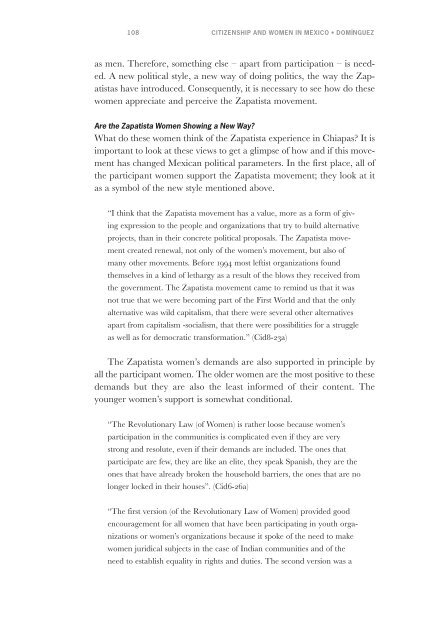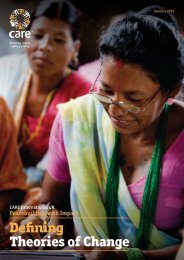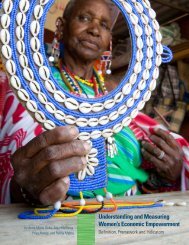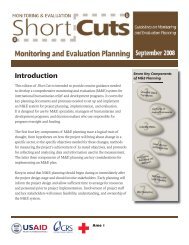Discussing Women's Empowerment - Sida
Discussing Women's Empowerment - Sida
Discussing Women's Empowerment - Sida
You also want an ePaper? Increase the reach of your titles
YUMPU automatically turns print PDFs into web optimized ePapers that Google loves.
108<br />
CITIZENSHIP AND WOMEN IN MEXICO • DOMÍNGUEZ<br />
as men. Therefore, something else – apart from participation – is needed.<br />
A new political style, a new way of doing politics, the way the Zapatistas<br />
have introduced. Consequently, it is necessary to see how do these<br />
women appreciate and perceive the Zapatista movement.<br />
Are the Zapatista Women Showing a New Way?<br />
What do these women think of the Zapatista experience in Chiapas? It is<br />
important to look at these views to get a glimpse of how and if this movement<br />
has changed Mexican political parameters. In the first place, all of<br />
the participant women support the Zapatista movement; they look at it<br />
as a symbol of the new style mentioned above.<br />
“I think that the Zapatista movement has a value, more as a form of giving<br />
expression to the people and organizations that try to build alternative<br />
projects, than in their concrete political proposals. The Zapatista movement<br />
created renewal, not only of the women’s movement, but also of<br />
many other movements. Before 1994 most leftist organizations found<br />
themselves in a kind of lethargy as a result of the blows they received from<br />
the government. The Zapatista movement came to remind us that it was<br />
not true that we were becoming part of the First World and that the only<br />
alternative was wild capitalism, that there were several other alternatives<br />
apart from capitalism -socialism, that there were possibilities for a struggle<br />
as well as for democratic transformation.” (Cid8-23a)<br />
The Zapatista women’s demands are also supported in principle by<br />
all the participant women. The older women are the most positive to these<br />
demands but they are also the least informed of their content. The<br />
younger women’s support is somewhat conditional.<br />
“The Revolutionary Law (of Women) is rather loose because women’s<br />
participation in the communities is complicated even if they are very<br />
strong and resolute, even if their demands are included. The ones that<br />
participate are few, they are like an elite, they speak Spanish, they are the<br />
ones that have already broken the household barriers, the ones that are no<br />
longer locked in their houses”. (Cid6-26a)<br />
“The first version (of the Revolutionary Law of Women) provided good<br />
encouragement for all women that have been participating in youth organizations<br />
or women’s organizations because it spoke of the need to make<br />
women juridical subjects in the case of Indian communities and of the<br />
need to establish equality in rights and duties. The second version was a

















